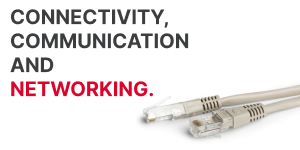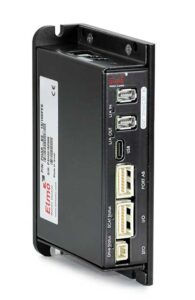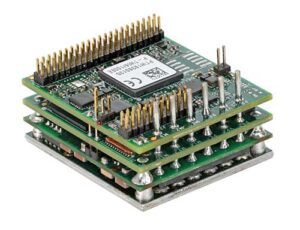Connectivity and communications
As we’ve previously noted, analog drives receive input from controllers as voltage signals that they amplify before sending them to the motor. They can’t communicate with other components within the motion system. Digital drives offer numerous interface options, optimizing performance, cost, and ease of use. An article could be written about these standards in depth but let us focus on some key points.
Serial interfaces
There are several types of serial communications links. Serial links are inexpensive and can be customized because they do not require licenses. They are commonly used for drive configuration and troubleshooting.
Serial data links like RS-232 were effective when they were introduced, but only supported a limited number of cables runs and speeds. It relies on single-ended signaling, so it is susceptible to electronic noise, which is a problem in industrial environments. Differential signaling is used in RS-422, a subsequent standard, to provide greater noise immunity. Additionally, it is significantly faster and supports longer cable runs. Therefore, it is more commonly used in aerospace and automotive applications that require high reliability. In both cases, RS-232 and RS-422 are point-to-point links and can only address one device. As a result of the RS-485 standard, which added serial addressing, multiple devices can be communicated with from a single terminal. Initially popular, RS-485 has been largely replaced by industrial Ethernet.
Despite USB’s faster speed and lower power requirements, it is less suitable for industrial applications due to its length limitations and noise vulnerability.
Digital networking [or industrial ethernet?]
Several digital communications protocols have been developed that support high-speed, independently addressable networked communications among digital components such as PLCs, motion controllers, drives, sensors, etc. Classic Ethernet delivers best-effort. Industrial Ethernet solutions have been modified to support high-speed optimization.
Different standards vary in terms of data transmission schemes, speed, jitter, topology, and the number of nodes. Connectivity optimizes a motion system. For applications that don’t require a high degree of synchronization, a fieldbus like CAN could provide sufficient performance, for example. For extremely complex motion such as reverse kinematics, a high-speed, low-jitter protocol like EtherCAT is required. The choice of protocol can also impact cost and flexibility. Proprietary protocols like Ethernet/IP and ProfiNET entail licensing fees and lock the OEM into a limited number of solutions. In contrast, open protocols like CANopen and EtherCAT are free to use and free users to choose from several options.
It is possible to operate the upper-level machine network in parallel with serial communications links. The EtherCAT protocol could be used for communication between the PLC, motion controller, drives, and sensors on a machine. Engineering can run serial communications over RS-422 in the background to troubleshoot the drive or observe a signal. It will not interfere with the machine network.
A drive’s compatibility with a particular protocol or communications link is essential. Also, they must be compatible with encoders, resolvers, and other types of sensors in the system. Ensure that the drive can read the signal from the sensor (and that the sensor output driver is selected to provide a powerful enough signal to be registered by the drive).
Size and form factor
Although it’s easy to focus on performance, a drive won’t do much good if it doesn’t fit in the system. There may be a problem if the mechanical design has been finalized before the choice of electronics has been made. In general, the greater the power, the larger the drive. An inefficient drive will generate waste heat that must be managed, either passively or actively. This consumes even more space, power, and budget. For space-constrained applications, look for high-efficiency, high-power-density drives.
Drives are available in housed and board-level designs. Housed drives can be installed in central cabinets or out on the machine in a distributed control system. Drives are also available in forms that can be integrated by the OEM into a custom PCB. This will enable an integrated drive solution that optimally fits their application, whether it be two axes or 20. The approach takes more skill, but the board-level approach supports innovative designs for specialty applications such as robotics, medical diagnostics, and aerospace.
Housed drives are separate units that are easy to install (left). Board-level drives (right) can be installed on the PCB, increasing the level of customization and innovation possible in the design.



